Anniversary
On February 12, 2021, Ivan I. Dedov, Academician of the Russian Academy of Sciences, an outstanding scientist with a worldwide reputation, celebrates his anniversary. Ivan I. Dedov is a leading clinician, endocrinologist, teacher, experienced organizer of healthcare in Russia. Ivan I. Dedov headed the Russian endocrinology at a difficult stage of its development. Under his leadership, clinical endocrinology, a narrow, largely secondary field, has now acquired the significance of a fundamental and priority clinical discipline.
The editorial board of the journal «Problems of Endocrinology» cordially congratulates its editor-in-chief and wishes him good health and many fruitful years for the benefit of Russian endocrinology.
Editorial notice
Radiotheranostics is a radionuclide therapy based on the results of molecular imaging with various radiopharmaceuticals, allowing in vivo whole body imaging (SPECT, PET), and then systemically and at the same time selectively acting on pathological metabolic processes caused by a pathological process. In recent years, thanks to advances in the development of nuclear medicine (an increase in the number of cyclotrons, SPECT / CT and PET / CT in medical institutions) and, particularly, novel radiopharmaceuticals — in the world, radiotheranostics is developing very rapidly. The emergence of new radioligands labelled by 177Lu, 131I, 225Ac and other radioisotopes in the world have initiated a large number of clinical trials of radioligand therapy of neuroendocrine and chromaffin tumors, prostate cancer, etc. Radiotherapy as a new and very promising direction of nuclear medicine and it is perfectly integrated into modern diagnostic algorithms in the field of endocrinology and oncology. Methods of intraoperative radionavigation make it possible to increase the efficiency and safety of surgical methods, external beam radiation therapy, and brachytherapy. In my opinion, the future of personalized medicine will be predominantly determined by the integration of radiotherapy, multimodal imaging, intraoperative navigation and existing/new methods of diagnosis and treatment, in combination with applied genomic and post-genomic technologies.
Endocrinology healthcare network and professional education
Clinical endocrinology
Backgraund: Acromegaly is a multi-organ disabling disease, the effectiveness of treatment of which directly depends on timely diagnosis. Latent course and delayed diagnosis increase the exposure of pathological hypersecretion of growth hormone and insulin-like growth factor-1, contributing to the development of irreversible systemic and metabolic changes in the body that negatively affect survival.
Aims: The aim of the study was to clinically test a comprehensive diagnostic approach using selective screening to detect cases of acromegaly in patients with combined somatic diseases.
Materials and methods: The diagnostic search algorithm included a 2-stage questionnaire, expert assessment of the clinical status, laboratory and instrumental examination. The inpatient examination included the use of additional laboratory and instrumental methods and expert evaluation of the results obtained by filling out a doctor’s questionnaire. When the score was higher than 18 points, a more specific examination was performed: double determination of the insulin-like growth factor-1 level, oral glucose tolerance test with determination of the nadir of growth hormone value, and MRI of the brain with contrast enhancement. The diagnosis of acromegaly was made on the basis of personal data, expert assessment of the clinical status, results of laboratory and instrumental examinations.
Results: A survey of 1249 patients with combined systemic and metabolic disorders conducted using the point system allowed us to suspect acromegaly in 367 patients (29.4%), who were offered further examination. The majority of patients were previously seen by specialists for diabetes mellitus (79.3%) or thyroid pathology (10%). In the result of inpatient examination of 329 patients, 35 (10.6%) patients showed an increase in the blood level of IGF-I. In 19 patients, a persistent increase in the level of IGF-I was combined with the absence of GH suppression of less than 0.4 ng/ml against the background of glucose load. During MRI in 9 patients, pituitary adenoma was detected (in 2 — microadenoma and 7 — macroadenoma).
Conclusions: As a result of the study, among the group of 1249 patients (mean age 58±13 years) with the presence of concomitant diseases, 9 newly identified patients with acromegaly were found who were prescribed adequate treatment. The introduction of selective screening technology into the practice of an endocrinologist will improve the effectiveness of diagnostic search for patients with acromegaly, more accurately assess the prevalence of the disease in Russia and the need for specialized medical care.
Background. The implementation of standardized protocols for combined treatment of cancer into clinical practice inevitably leads to a long-term consequence.
Aims. To study the prevalence of endocrine disorders, to assess the prevalence and degree of decline of bone mineral density (BMD) in individuals who have undergone combined treatment of malignant brain tumors in childhood and adolescence.
Materials and methods. A retrospective study was conducted with 59 young adults (31 men; 28 women) who have undergone surgical treatment of malignant brain tumour followed by radiation treatment (craniospinal radiation in combination with or without polychemotherapy). Group I consisted of 37 patients, who were treated between the ages of 3 and 16 years. Group II included 22 patients who received treatment between the ages of 16 and 38 years.
Results. GH deficiency according to the results of the insulin hypoglycemia test was diagnosed in 48 patients (81%), 22 patients had secondary adrenal insufficiency (37%). The majority of those examined (33 patients (56%)) did not achieve the target growth. Only 5 people from I group was treated with recombinant GH. Correlation analysis demonstrates that age of treatment is the main factor affecting final growth (r=0,619, p<0,001). Many cases of hypothyroidism (n=39 (66%)) and hypogonadism (19 women; 17 men) were detected. According to the DXA, a decrease of BMD ≤-2.0 SD (Z-score) in L1–L4 was found in 35 of 59 patients (59%). The BMD in the I group was significantly lower than in patients treated at an older age (p<0.001). A moderate correlation was discovered between BMD in L1–L4 at the time of examination and the level of estradiol in women (r=0.596, p<0.05) and testosterone in men (r=0.472, p<0.05). Direct correlation between BMD and age of diagnosis was revealed (r=0.781, p<0.01).
Conclusions. The results show that patients need to be monitored annually and for life after the combined treatment of malignant brain tumors in order to detect the long-term effects of the treatment. The high incidence of osteopenic conditions determines the relevance and need for early diagnosis to prevent further bone loss, reduced bone strength and the risk of fractures.
Background: Quality of life (QoL) assessment before and after surgical treatment in patients with primary hyperparathyroidism (PHTP) may be useful for comprehensive evaluation of the treatment effect, as well as for monitoring of the patient’ condition after surgery, including in real clinical practice.
Aim: The aim of the study was to validate and test the Russian version of the PHPQoL questionnaire for assessment of the quality of life (QoL) in patients with primary hyperparathyroidism (PHPT) for further application in clinical practice and research in Russia.
Materials and methods: The linguistic and cultural adaptation of the PHPQoL questionnaire was carried out in accordance with international guidelines. Psychometric properties of the tool, namely, its reliability, validity and sensitivity were tested in the focus group of patients with PHPT
Results: In the whole, 65 patients with PHPT were involved into the study (mean age — 52.3 ± 10.5 years, 97% — women): 67.7% patients were symptomatic, 35.4% patients had moderate or severe hypercalcemia. All the patients filled out the Russian version of PHPQoL before parathyroidectomy. One third of patients filled out the Russian version of PHPQoL twice — before surgery and 3 months after surgery. Satisfactory external and content validity of the Russian version of PHPQoL was demonstrated. Its stable structure confirmed satisfactory construct validity of the questionnaire. The ability of the tool to determine differences in severity of symptoms/problems due to PHPT before and after treatment was revealed. The positive effect of the surgery on QoL in PHPT patients was shown.
Conclusion: The results obtained during the study confirm that the Russian version of PHPQoL is a reliable, valid and sensitive tool. Feasibility and applicability of its use in research and clinical practice in Russian endocrinology settings has been demonstrated.
The exact physiological basis for the suppression of growth hormone secretion by oral glucose intake remains unknown, despite the widespread use of the oral glucose tolerance test in endocrinology. Lack of growth hormone suppression by glucose occurs in about a third of patients with acromegaly, as well as in other disorders. It is currently known that the secretion of growth hormone is affected by various factors, such as age, gender, body mass index, and the redistribution of adipose tissue. There is also evidence of the impact of overeating as well as being overweight on the secretion of growth hormone. It is known that both of these conditions are associated with hyperinsulinemia, which determines the possibility of its predominant role in suppressing the secretion of growth hormone. The purpose of this review is to discuss the accumulated data on the isolated effects of hyperglycemia and hyperinsulinemia on growth hormone secretion, as well as other metabolic regulators and conditions affecting its signaling. Understanding of the pathophysiological basis of these mechanisms is essential for further research of the role of glucose and insulin in the metabolic regulation of growth hormone secretion. However, the studies in animal models are complicated by interspecific differences in the response of growth hormone to glucose loading, and the only possible available model in healthy people may be the hyperinsulinemic euglycemic clamp.
Background: The Republic of Tyva is a region with a proven severe natural iodine deficiency and a high prevalence of IDD (iodine deficiency disorders). However, in the region in certain periods of time, measures were taken to eliminate iodine deficiency in the diet of the population. The article presents the results of the October 2020. by specialists of the Endocrinology Research Centre, a control and epidemiological study aimed at assessing the current state of iodine supply in the population of the Republic of Tyva. The study was carried out on behalf of the Ministry of Health of Russia within the framework of the state task «Scientific assessment of the need to take additional regulatory legal and other measures to eliminate iodine deficiency in pilot regions with severe iodine deficiency».
Aim: Assessment of iodine supply of the population of the Republic of Tuva.
Materials and methods: The research was carried out in three settlements of the republic — years. Kyzyl, Shagonar, Saryg-Sep settlement. A total of 227 pre-pubertal schoolchildren (8–10 years old) were examined with anamnesis collection, examination by an endocrinologist, palpation of the thyroid gland, collection of single urine samples into disposable eppendorfs, followed by freezing to minus 20–25 degrees to further determine the concentration of iodine in urine with using the cerium-arsenitic method in the laboratory (clinical diagnostic laboratory of the Federal State Budgetary Institution «National Medical Research Center of Endocrinology» of the Ministry of Health of Russia). In addition, all schoolchildren underwent an ultrasound examination of the thyroid gland (using a portable ultrasound machine LOGIQe (China) with a multifrequency linear transducer 10–15 MHz, in the supine position). The height and weight of children was determined according to the standard method at the time of the examination. A collection of samples of edible salt, which is used in families of schoolchildren, was carried out and the presence of iodine in it was determined by an express method for the qualitative determination of potassium iodate.
Parents of schoolchildren signed informed consent for the examination of children. Permission of the local ethical committee of the Endocrinology Research Centre — received, date: March 25, 2020, N 5.
Results: 227 schoolchildren of 8–10 years old were examined. The median concentration of iodine in urine was determined, the presence of iodine in food salt was investigated, and an ultrasound examination of the thyroid gland was carried out in order to clarify the iodine supply, the coverage of the use of iodized salt in nutrition and the prevalence of goiter.
The median concentration of iodine in urine was 153 μg/l, the frequency of goiter was 7.7%, and the proportion of households using iodized salt was 95.2%.
Conclusion: Results of assessment (median urinary iodine concentration) confirm that population of Tuva, Russian Federation, has optimum iodine nutrition. The prevalence of goiter in schoolchildren significantly decreased compared to earlier assessments. The proportion of households using iodized salt indicates the effectiveness of preventive measures in the region.
Reproductive Endocrinology
One of the new directions in the study of reproductive disorders in obese women is the effect and receptor sensitivity of melatonin on the gonadotropic function of the pituitary gland and ovariogenesis, taking into account the chronology of «light pollution». At the present stage, there is very little literature on the influence of the aspects of «light pollution» on the problem of obesity and reproductive disorders in the literature. This review is an attempt to combine the above problem in terms of the impact of «light pollution» and the level of receptor sensitivity of melatonin in women of reproductive age with obesity. The literature search was carried out in Russian (eLibrary, CyberLeninka.ru) and international (PubMed, Cochrane Library) databases in Russian and English. Free access to the full text of the articles was a priority. The selection of sources was prioritized for the period from 2015 to 2019. However, given the insufficient knowledge of the chosen topic, the choice of sources was dated from 1992. The work was carried out as part of the study «Central and peripheral pathophysiological mechanisms of development of adipose tissue diseases, taking into account clinical and hormonal characteristics» 2020–2022.
Backgraund: obesity/overweight in women are often the causes of menstrual dysfunction and infertility.
Aims: To identify the association between overweight/obesity and IVF outcomes.
Materials and methods: retrospective study — data of 1874 patients undergoing IVF in the Endocrinology Research Centre (2012–2019) was analyzed. Exclusion criteria: BMI <18.5 kg/m2, polycystic ovary syndrome, donation of oocytes, ectopic pregnancy, fertilization with partner’s epididymal/testicular sperm. The study included 1583 women aged 21–45 years (median 33.0 y.o. [30.0; 37.0], median BMI 23 kg/m2 [20.7; 26.2]). Statistical data processing was performed using the STATISTICA application package (StatSoft). The threshold level of statistical significance is <0.05.
Results: Patients were divided into 5 groups (gr.): normal body weight (NBW) - 1061 people (ppl.) (gr. 1), overweight — 368 (gr. 2), class I obesity — 117 (gr. 3), class II obesity — 36 (gr. 4), class III obesity — 1 (gr. 5). In each group, the estimated pregnancy rate (PR) and its outcomes, the frequency of lightweight newborns (body weight at birth <2500g), newborns with NBW (2500-3999g), births with a large fetus (≥4000g) were measured. The PR didn’t differ: 34.6%, 34.5%, 30,7%, 41,7%, respectively, the woman in gr.5 got pregnant. Among 407 (74.4%) singleton pregnancies urgent delivery was registered in 71.91%, 67,57%, 70,83%, 60,0%, gr. 5 — no information. Premature birth: 7,66%, 5,41%, 8,33%, 0%. Spontaneous abortion in the 1st trimester: 18,30%, 25,68%, 20,83%, 40,0%. Spontaneous abortion in the 2nd trimester: 2,13%, 1,35% in gr. 2, 3, 4. Lightweight newborns: 8,81%, 11,36%, 6,25%, 0%. Newborns with NBW: 84,91%, 84,09%, 75,0%, 60,0%. Large-childbirth — 6,29%, 4,55%, 18,75%, 40,0%.
Conclusions: Correlation analysis of the dependence of PR and its outcomes on the BMI was not revealed (p=0.975 and p=0.469, respectively). Large fetus births were more often detected in obese patients (p=0.0016). A large prospective group is needed to expand the estimated body parameters to the IVF outcomes.

This work is licensed under a Creative Commons Attribution-NonCommercial-NoDerivatives 4.0 International License (CC BY-NC-ND 4.0).
ISSN 2308-1430 (Online)




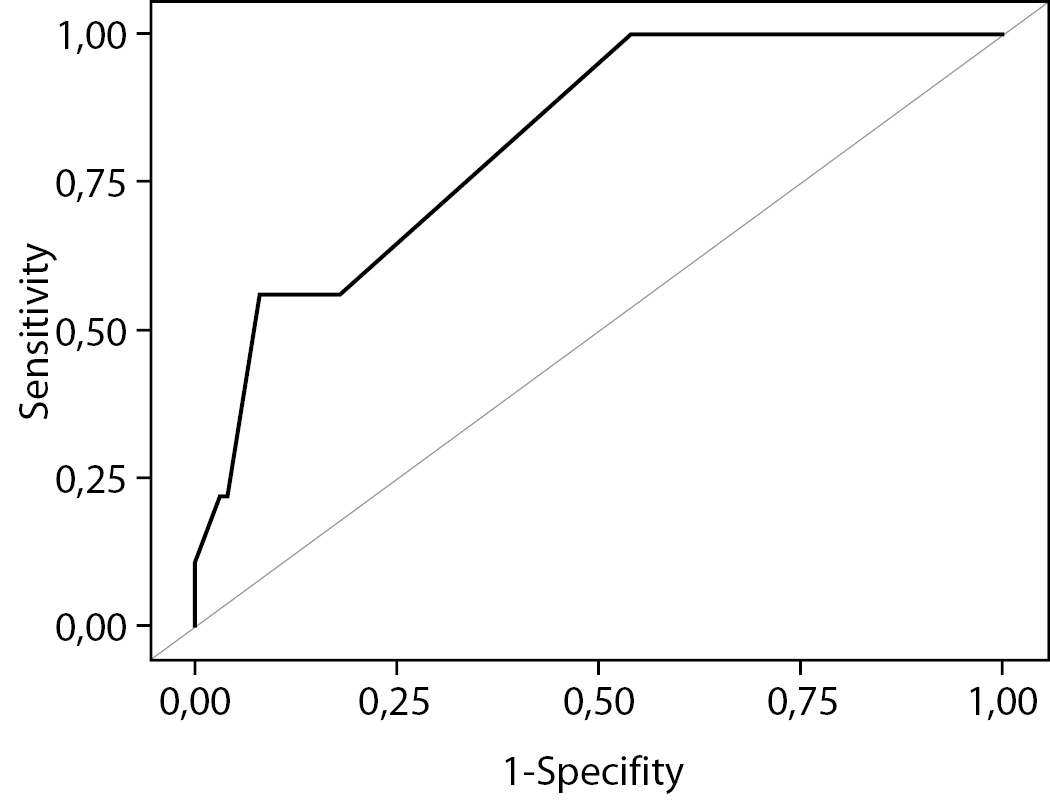
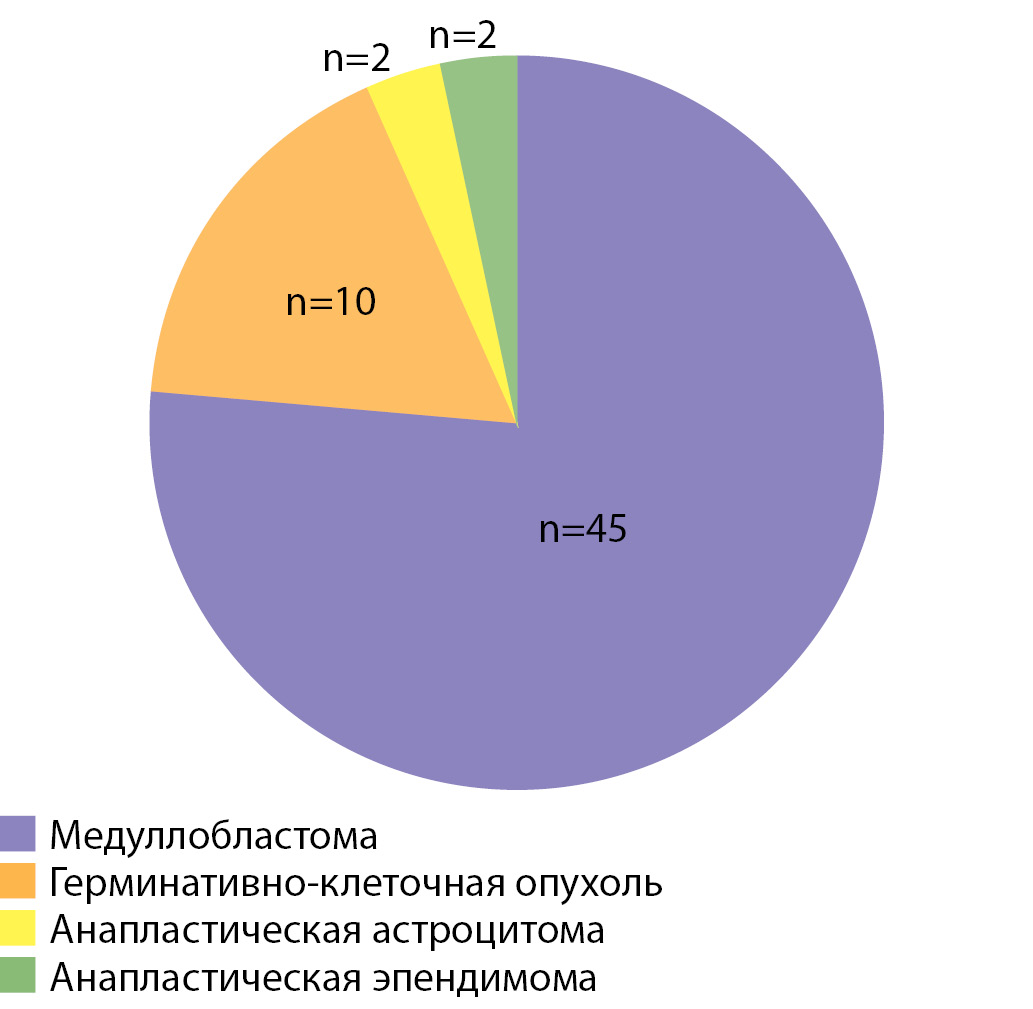
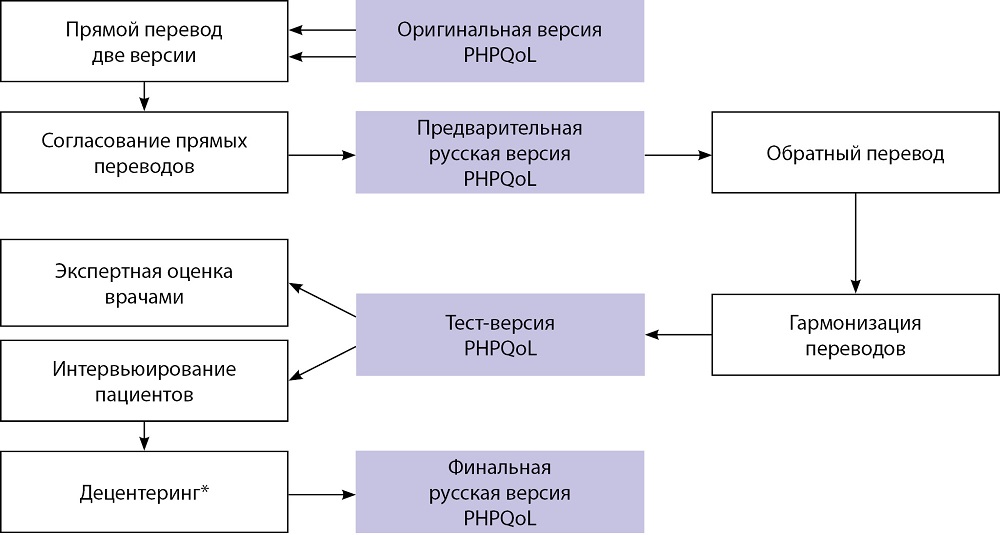

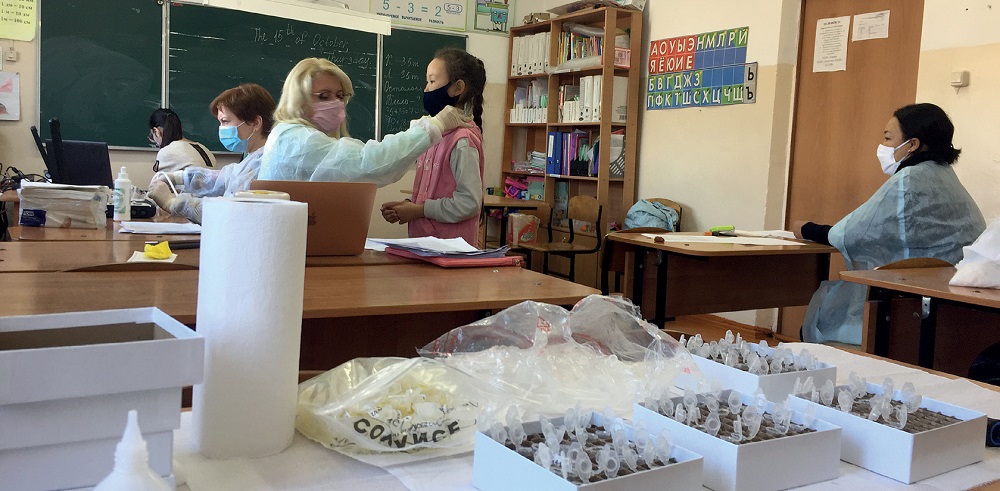
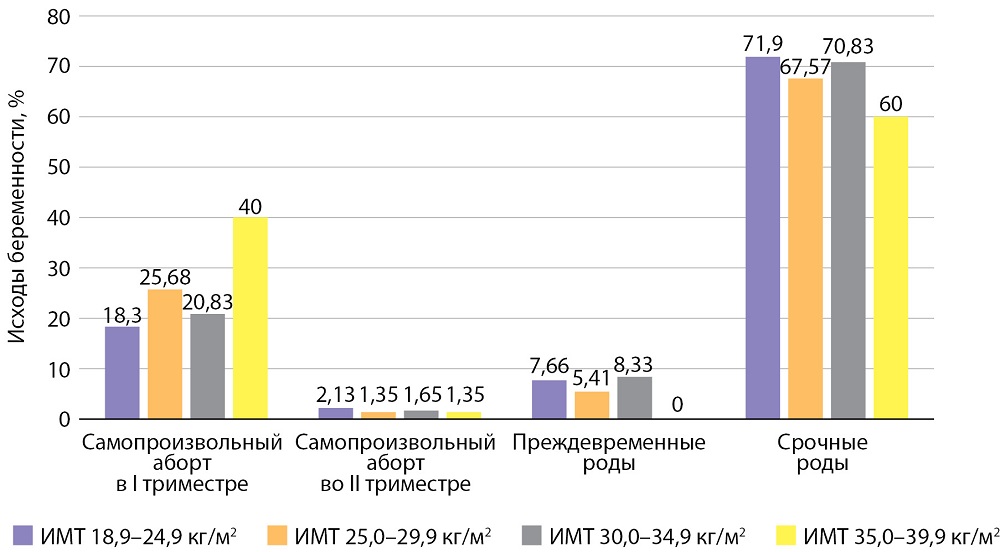





































.jpg)


